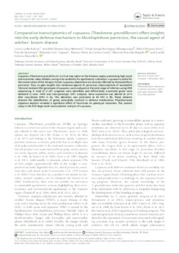Comparative transcriptomics of cupuassu (Theobroma grandiflorum) offers insights into the early defense mechanism to Moniliophthora perniciosa, the causal agent of witches' broom disease.
Comparative transcriptomics of cupuassu (Theobroma grandiflorum) offers insights into the early defense mechanism to Moniliophthora perniciosa, the causal agent of witches' broom disease.
Autoria: FALCAO, L. L.; WERNECK, J. O. S.; ALBUQUERQUE, P. S. B.; ALVES, R. M.; GRYNBERG, P.; TOGAWA, R. C.; COSTA, M. M. do C.; BRIGIDO, M. M.; MARCELLINO, L. H.
Resumo: Cupuassu (Theobroma grandiflorum) is a fruit tree native to the Amazon region, presenting high social and economic value. Besides, owing to its suitability for agroforestry cultivation, cupuassu is useful for the conservation of the Amazon Forest. Cupuassu plantations are severely affected by Moniliophthora perniciosa. Thus, to gain insights into resistance against M. perniciosa, transcriptomes of susceptible (SG) and resistant (RG) genotypes of cupuassu were analyzed at the early stage of infection using RNA sequencing. A total of 21,441 unigenes were identified, and differentially expressed genes were detected in intra- (440) and inter-genotype (301) analyses. Gene expression was altered at 24 h after inoculation (HAI) in SG. This alteration was prominent at 48 HAI in RG. These datasets allowed the identification of genes potentially involved in defense mechanisms. Phytohormone signature analysis revealed a significant effect of hormones on genotype responses. The present study is the first large-scale transcriptomic analysis of cupuassu.
Ano de publicação: 2022
Tipo de publicação: Artigo de periódico
Unidade: Embrapa Amazônia Oriental
Palavras-chave: Differential gene expression, Functional genomics, Plant-pathogen interaction, RNA-Seq, Transcriptome
Observações
1 - Por padrão são exibidas publicações dos últimos 20 anos. Para encontrar publicações mais antigas, configure o filtro ano de publicação, colocando o ano a partir do qual você deseja encontrar publicações. O filtro está na coluna da esquerda na busca acima.
2 - Para ler algumas publicações da Embrapa (apenas as que estão em formato ePub), é necessário ter, no celular ou computador, um desses softwares gratuitos. Sistemas Android: Google Play Livros; IOS: iBooks; Windows e Linux: software Calibre.
Acesse outras publicações
Acesse a Base de Dados da Pesquisa Agropecuária (BDPA) para consultar o acervo completo das bibliotecas da Embrapa.

